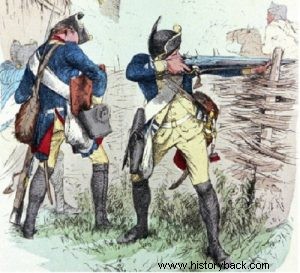
The 13th Musketeer Regiment was one of the best in the Prussian army and Europe, in its time. His men fought superbly in every conflict they were called to participate in, writing an indelible page of glory and earning for their regiment the nickname:"Lightning and Lightning Regiment".
The constitution was formed in 1685 manned by French Protestants (Huguenots) who were expelled from their homeland and settled in Prussia.
In 1687 it was incorporated into the 15th Constitution. In 1702 it was re-established and fought in the War of the Spanish Succession (1700-15) and in all the subsequent wars in which the Prussian army participated, until the destruction of 1806. It was called the regiment of "Lightning and Lightning" because the his men were so well trained that they could launch continuous, uniform volleys.
War action
During the Silesian Wars, he took part in three of the four major battles with the Austrians and distinguished himself in all of them. With the beginning of the Seven Years' War in the 13th he participated in the Prussian invasion of Saxony and took part in the first major battle of the war at Lobozic (1756) , attached to the brigade of his honorary commander, Lieutenant General von Itsenplitz.
The 13th fought superbly by abandoning its linear formation and fighting in a strafing formation , due to the terrain and the presence of numerous Austrian light troops. After the capture of Lobos hill by the Prussians, the Austrians retreated admitting their defeat.
The 13th also participated in the particularly bloody battle of Prague (May 6, 1757). Under the direct command of King Frederick's brother, Prince Henry of Prussia, the regiment, crossing rough terrain and a small river with steep banks, found itself on the side of the Austrians causing confusion. Then, with the reinforcement of grenadier battalions, he broke through the Austrian line forcing the enemy to retreat.
He took part, again with distinction, in Frederick's famous victories at Rosbach (November 5, 1757) and Luten (December 5, 1757). In the second case it formed the spearhead of the Prussian attack on the opposing left flank. After putting the light Austrian divisions to flight, he disbanded a regiment of Württemberg (Austrian allies). He then advanced in depth, captured 14 Austrian guns and disorganized an entire Austrian corps.
In 1758 he took part in the ill-fated siege of Schweidnitz and the invasion of Moravia. On October 14, he took part in the battle of Hochkirch, which was unfortunate for the Prussian arms. He fought heroically there too, suffering 75% losses without breaking. It was reorganized and in 1759 took part in the conflicts at Pretz and Hojerswerda. The following year he took part in the battles of Liegnitz, Hoggiersdorf and the fatal battle of Torgau. In 1762 he took part in the battle of Burgersdorf.
However, the regiment had a reputation for "eating" its honorary commanders, and indeed many of them were killed. Of these, von Waldburg was killed in 1745 at Hohenfriedberg, von Pohlenz was mortally wounded at Kesseldorf in 1745, von Eichenplitz was killed at Kunerzdorf, in 1759, The Russian Tsar Peter III, who was assassinated.
Organization
The regiment was organized into two combat battalions each with four companies of musketeers (line infantry) and one company of grenadiers. The musketeer companies had a strength of 150 men. Those of the grenadiers had a strength of about 120 men. The grenadier companies of the regiments each formed four independent battalions of elite men that were used as shock units.
There was also a field battalion to supply the combatants with replacements. The total strength of the regiment reached 1,800 men together with its staff and the craftsmen (carpenters, gunsmiths, horsemen, transport men). The regiment had its own priest, arch-doctor, military officer, field officer.
Commanded by a colonel or lieutenant colonel. Each battalion was commanded by a major. Each company was commanded by a captain. He also had a lieutenant, two second lieutenants, one or two probationary officers and 16 non-commissioned officers. Finally, the regiment had 38 drummers and 12 more musicians.


The 13th is led by Prince Henry of Prussia himself (brother of M. Frederick) in the battle of Prague in 1757.

Grenadiers of the 13th fight the Austrians.

